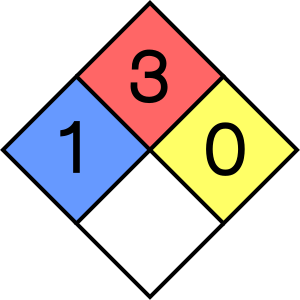3-PENTANONE
Basic information
- Chemical formula(s): \({\rm (CH_3CH_2)_2CO}\), \({\rm C_5H_{10}O}\)
- Other names: dimethylacetone, methacetone, diethyl ketone
- CAS: 96-22-0
- International Chemical Safety Card (ICSC): 0874
- Flammability: yes - highly flammable
- NOAA’s description: clear colourless liquid with an acetone-like odour, less dense than water, vapours heavier than air
NFPA 704 (fire diamond)

- Health (blue): 1 - exposure would cause irritation with only minor residual injury.
- Flammability (red): 3 - it can be ignited under almost all ambient temperature conditions. Its flash point is 12.8 °C. It’s autoignition temperature is 425 °C.
- Instability–reactivity (yellow): 0 - normally stable, even under fire exposure conditions, and is not reactive with water.
- Special notice (white): -
Hazard statements
| Code | Phrase |
|---|---|
| H225 | highly flammable liquid and vapour |
| H335 | may cause respiratory irritation |
| H336 | may cause drowsiness or dizziness |
Precautionary statements
| Code | Phrase |
|---|---|
| P210 | keep away from heat, hot surfaces, sparks, open flames and other ignition sources, no smoking |
| P233 | keep container tightly closed |
| P240 | ground and bond container and receiving equipment |
| P241 | use explosion-proof electrical/ventilating/light/…/equipment |
| P242 | use only non-sparking tools |
| P243 | take precautionary measures to prevent static discharges |
| P261 | avoid breathing dust/fume/gas/mist/vapours/spray |
| P271 | use only outdoors or in a well-ventilated area |
| P280 | wear protective gloves/protective clothing/eye protection/face protection |
| P303+P361+P353 | IF ON SKIN (or hair): remove/take off immediately all contaminated clothing, rinse skin with water or shower |
| P304+P340 | IF INHALED: remove victim to fresh air and keep at rest in a position comfortable for breathing |
| P312 | call the ETH Emergency Desk: +41 44 342 11 88 (from mobile) or 888 (from landline) if you feel unwell |
| P370+P378 | IN CASE OF FIRE: use dry sand, dry chemical or alcohol-resistant foam to extinguish |
| P403+P233 | store in a well ventilated place, keep container tightly closed |
| P403+P235 | store in a well ventilated place, keep cool |
| P405 | store locked up |
| P501 | dispose of contents/container to HCI-Shop |
Protective measures
Gloves
Occupational Safety and Health Act of 1970 and OSHA Glove Selection Chart do not provide recommendation on gloves for handling 3-pentanone. Safety data sheet from Agilent categorizes gloves for normal use and direct contact with the chemical. The levels of protection against 3-pentanone for four types of gloves are:
- Neoprene: N/A
- Natural latex or rubber: N/A
- Buthyl: good, recommended for direct contact with the chemical, 240 min breakthrough time for 12-15 mil thickness.
- Nitrile: fair, but recommended for normal use - 60 min breakthrough time for 11-13 mil thickness.
Safety goggles
- Always wear safety goggles when handling 3-pentanone. Corrective glasses are not considered safety googles.
- Handle 3-pentanone inside the fume hood only (with exception of moving the closed bottle to and from the storage cabinet).
Clothing
- Wear long trousers and fully covered shoes.
- Contact lenses are forbidden while working with chemical substances, even in combination with safety glasses.
- Do not wear cosmetics.
- Do not wear synthetic clothing while working with flammable liquids or gases or when a hazard is present as these materials tend to melt and stick to exposed skin.
- Do not wear headphones.
Spill management
- Use personal protective equipment.
- Avoid dust formation, avoid breathing dust.
- Avoid breathing vapors or mist.
- Ensure adequate ventilation.
- Evacuate personnel to safe areas.
- Sweep up without creating dust and arrange disposal.
- Do not let it enter drain.
- If a spill happened outside the fume hood (on the floor or desktop) contact Dr Jakub Tkaczuk (+41 44 632 31 62) and the ETH Emergency Desk (+41 44 342 11 88 from mobile or 888 from landline).